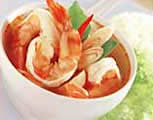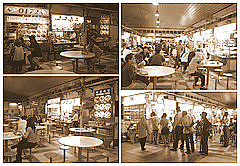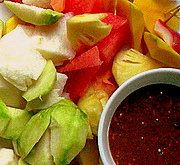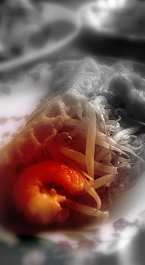foods.
THAILAND
tangy lemongrass & fiery chillies
I’ve been to Thailand twice so far and I never fail to be struck by how culturally & historically rich the Thais’ are. Their unique brand of identity and style are continually reflected in their refined cuisine- from kaeng (curry), to yam (hot & pungent salads) to khanõm (sweets & desserts).
History Lesson #1: Thailand was the only SEA country that was never occupied by Western imperialists.
History Lesson #2: 90% of all Thais are Buddhists, practicing Theravada Buddhism.
Kaeng – curry
Kaeng is applied to any dish with a lot of liquid, from the bland soups, such as kaeng jèut, to famous chilli-based Thai curries, like kaeng kiaw-waan (green curry; see below).The key to any Thai curries (there are many many varieties) is the khreuang kaeng, or the curry paste, which is thicker than the traditional Indian curry paste and with fish sauce and shrimp paste instead of Indian-style curry powder as essentials to the Thai kaeng. green curry
green curry
Yam– salad
From experience, I can tell you that yam, even the vegetarian ones, are not to be trifled with. The ingredients are deceptively simple- leafy veggies like lettuce, chillies, lemongrass, lime juice & fish sauce, peanuts and fruit dressing like fresh sweet mangoes. There’s no or very little cooking involved, almost like the Chinese rojak found here in Singapore but without the fried char kuay. The sweet-sour taste of the mangoes and lime juice is paired nicely with the intense spiciness from the chillies
 seafood salad
seafood salad
Kaeng Jeut & Tom Yam– soups
Absolutely no one leaves Thailand without tasting the famous soups. Tom yam or sweet & sour soup (actually ‘tom yam’ literally translates to ‘boiled yam’) is usually made with seafood and has that signature spicy-sweet-sourness from the dried chillies, lemongrass, kaffir lime & tamarind juice. Tom yam isn’t meant to be eaten by itself; rice usually accompanies it- I suppose to provide some relief from the intense heatiness of the dish.
Kaeng jeut on the other hand is bland soup, a broth seasoned minimally with fish sauce & pepper. This is clearly a Chinese influence especially in North Thailand where the stewed meat soups are eaten with noodles, with the thick soup flavoured unusually by soy sauce & Chinese celery & Chinese five-spice mixture.
 tom yam goong
tom yam goong
“Ráwn!” –“Hot!”
Khanom/ Khawng Waan– sweets
Desserts in Thailand are a very welcomed relief with all those spicy foods around. Coconut milk and sugar cane are some of the most essential ingredients in a Thai dessert. The owner of a local thai sweet shop gave me a wrap made of threads of spun sugar (I love it. Like cotton candy but tastier) or what I knew later to be fawy thawng (‘golden threads’). Apparently, there are Portuguese influences in sweets like the fawy thawng which have egg yolks as ingredients in their desserts, almost like deserts like the Portuguese egg tarts.
 golden threads
golden threads
There’s also the ta-ko which looks like the sweets sold by Malay-Muslim stalls in Singapore during the fasting month of ramadhan, which is essentially tapioca flour and coconut milk over agar-agar, poured & cooled in square-ish cups made from pandan leaves. Another snack popular among the street vendors there is the banana fritters- while it’s fried in the usual batter, there’s a twist- on top of the sweetness of the bananas, there is also a surprise appearance from chillies and an added crunch from the generous sprinkling of toasted lotus/sesame seeds.
 ta-ko
ta-ko
Food in Religion
In Thailand, animalism (the belief that all things have souls) and buddhism often go hand-in-hand. Daily food offerings are made to the dieties and spirits or phii first and it only once they are appeased that devotees attend to their Buddhist faith. Rice, curry & other dishes make their way to the Buddhist monks, Buddha’s direct advocates. Foods are especially important in events like the bangpaja– a ceremony where a young male is inducted into the monastic community. Here, the bun or religious merit is translated to the food prepared for such an event, where eating are said to be akin to kin bun or eating merit.
Another example is some believe that in the event of an imminent solar eclipse, a green-headed god, Rahu, is threatening to eat the sun in order to throw the whole world into an endless winter, and the only way to fend off this impending doom is to offer the god 8 different black foods such as black eggs, black desserts, black (burnt) chicken and sticky rice. It is said that it is only because the Thais practice this offering, the earth has been “saved” from disaster.
 black foods for god Rahu
black foods for god Rahu
Thus as in Vietnam, many religious festivities and events in Thailand (among which are the Songkran Festival, the Golden Orange Festival and the Vegetarian Festival), foods never fail to not only play an important functioning symbolic roles at events, but also make the celebrations even livelier and more memorable.
Delicious, delicious.
แกงจืดจึงรู้คุณเกลือ–
We only appreciate the worth of salt when the soup is tasteless.
Thai proverb
References:
World Food Thailand, 1st Edition, Joe Cummings, 2000, Lonely Planet Publications Pte Ltd: Victoria, Australia.
At the South-East Asian Table, Alice Yen Ho, 1995, Oxford university Press: Kuala Lumpur
Cuisines of Southeast Asia: a culinary journey through Thailand, Myanmar, Laos, Vietnam, Malaysia, Singapore, Indonesia, and the Philippines, Gwenda L. Hyman, 1993, Thomas Woll: Toronto



















 gabogan
gabogan gayah
gayah lawar
lawar sop ubi
sop ubi bakso
bakso soto ayam
soto ayam sayur lodeh
sayur lodeh dadar
dadar bubuh injin
bubuh injin

 tom yam goong
tom yam goong








